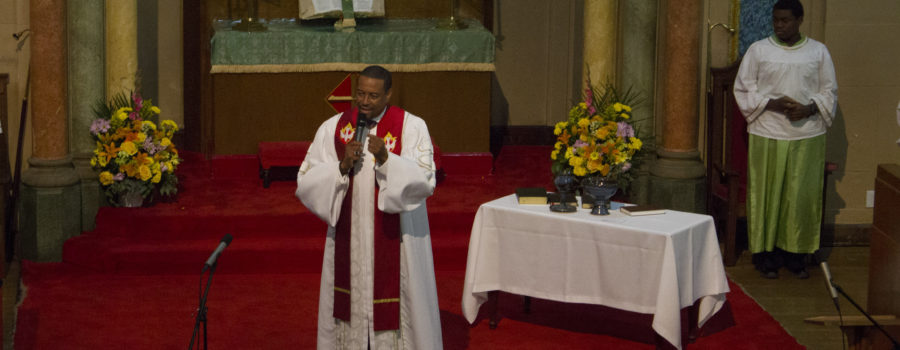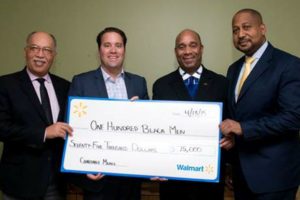This article was originally written for a course at Columbia University’s Graduate School of Journalism and published on The Columbia Journalist.
On a recent September Sunday, a choir of about 20 members in pale blue robes stood on the right side of the sanctuary and faced the congregation. In front of them a man played the drums while another man simultaneously played the piano and directed the choir. The music was upbeat, a gospel song called “I’ll Get Home Someday,” with the lyrics: “I’ll make it home someday, I know I’ll make it.”
It was an appropriate choice in music for a congregation with a new pastor, The Rev. Dr. Marvin Moss, who hopes to make some changes in central Harlem’s Salem United Methodist Church. Moss is a tall black man with larger than life energy; the pulpit barely seems large enough to contain him.
Wearing a white robe with a tie peeking out the top, he stood up and began clapping in big, dramatic gestures, encouraging the congregation to join him. Members of the church began to stand, clapping and swaying with the music. One passionate singer in the front row closed her music folder and set it on the chair behind her to clap along. Other members gradually followed suit.
When the choir finished their song, the congregation applauded. A white tourist in a leather coat and jeans, with aviators perched on top of his curly brown hair, held up a camera. An older black man in a suit, an usher, came over and quietly asked him to turn off his flash.
The pastor welcomed both members and visitors. “I said we are going somewhere, we are going somewhere,” Moss said. “We are moving forward because backwards is not an option.”
Salem is an unassuming church, a brick building dwarfed by the surrounding St. Nicholas houses, a New York City Housing Authority (NYCHA) development. A yellowing marquee sign on the front of the building declares “Open Hearts, Open Minds, Open Doors, All are welcome!” This aging building does not reflect the significant role this church once played.
Moss is a new face in Harlem. He was a well-known pastor in Atlanta, after taking his first church from the brink of closing its doors to having over 1200 members in six years. He also helped his second church’s congregation grow and has now been invited to Harlem to revive Salem, which has a shrinking and aging congregation.
The competition may be tougher here. Located in central Harlem, Salem sits in an area surrounded by other churches with similar worship styles, but some members say the Moss spirit is already catching on.
“Rev. Moss really, in such a short time, has allowed to the church to open its doors, whereas before it didn’t seem to as much,” said Steven Smart, 40, who has been a member of Salem since 2007.
Moss, originally from North Carolina, was working for Wachovia Bank in Atlanta when he felt a calling to become a pastor in 1993. After attending Gammon Theological Seminary and completing his doctoral work at Drew University, he got his first appointment at St. James United Methodist Church in Alpharetta, Ga., a northern suburb of Atlanta. Though the church was slated to close its doors, Moss grew the membership, and raised the funds to purchase 15 acres of land and build a new building in his six years there. In 2006, he was transferred to Cascade United Methodist Church in Atlanta. After seven years there, he began conversations with Bishop Martin McLee about moving to Salem in New York.
Though Moss has only been in Harlem since July, he has already made some changes at Salem. In the last few weeks, much of the sanctuary has gotten a fresh coat of white paint. The weekly service bulletins are now being printed in color and feature the church’s new Facebook page and Twitter handle.
“Salem is in what I would call a rebirth phase,” said Moss.
Joy Hill, 40, a member of St. James in Alpharetta, Ga., where Moss was first appointed, came to visit Salem and noticed the new bulletins. “I’m sure he is going to straighten a whole lot out,” she said, laughing. She noted that he made similar changes at her church when he was there.
Moss is hoping to build on the church’s successes in providing social services to the community. Every Wednesday, the church offers a free lunch and bible study to community members with a program they call “Word and Lunch,” which about 200 people attend every week. On Fridays, a food pantry attracts more than 200 community members, with a line that winds all the way around the church. The food pantry offers more than just food, with opportunities for community members to get information about healthcare and other services.
Moss wants to expand these community service programs, especially for young people in particular. He feels that these programs are important for Salem because of its location within the St. Nicholas houses. The development was built around their property in 1954, 30 years after Salem moved to its current location.
“People don’t like to be looked down on, they don’t like to be perceived as needing charity or anything like that,” Moss said. “We’re part of the community, so that’s how we want to position ourselves. It’s really unique and I think it provides a wonderful opportunity.”
Reaching out to the community is more than just charity. Moss also hopes these efforts will attract new members. When asked if he’s hoping to grow the church in Harlem in the way he grew his churches in Atlanta, he said, “I’d better grow it or I’ll be looking for another job!”
Because Salem’s members tend to be over 60, members of the church are hoping that Moss will be able to attract younger congregants to come in and work with the existing older members. One way in which Moss has been able to connect to a younger demographic is to emphasize that people don’t need to dress a certain way to come to church, said Smart.
“He’s able to keep the mature crowd, because you don’t want to alienate them, that’s your base,” said Smart. “And then he’s also able to usher in some new fresh minds, thoughts, spirits.”
Moss has already inspired RJ Wright, 19, to go to church more often, despite the fact that he has moved to the Bronx. He said that the sermons have been more relatable and that “the commute is very worth it.”
“Your ministry must be relevant and speaking the language of the people, whatever that language is,” Moss said. For Moss, speaking the language means accepting people no matter what their past might be, and helping them to grow in the church community.
This is the same community-driven attitude that Moss cultivated at his previous churches. Members of those congregations are quick to point out how well-known Moss was in the Atlanta community and how much he was able to help their churches.
“He was great at bringing people together, young and old,” said Kathleen Bertrand, a member of Cascade in Atlanta. “He felt that the church was a light in the community. We couldn’t just be a church on Sunday, we had to have our church be known everyday of the week.”
She said that there was something going on in their church everyday and that outreach and charity were a big part of their ministry. Joy Hill, a member of St. James, agreed, saying that Moss had strong connections with the community.
Churches occupy an important place in the culture of Harlem. During the Harlem Renaissance in the 1920s, the number of churches in Harlem grew rapidly, according to the Encyclopedia of the Harlem Renaissance. Religious communities were important for black residents, representing a social center and also a place where individuals could exercise power.
Salem’s founding pastor, Frederick Cullen, was known for openly soliciting members to his church, playing marbles with children on Harlem sidewalks and then inviting their families to church, according to the encyclopedia. Founded in 1902, Salem was unusual for the time because the ministry emphasized not only the spiritual lives of members, but the whole person. Cullen also created a monthly publication for the church, The Announcer, at a time when churches rarely produced journalism.
Cullen and his wife adopted the well-known black poet Countee Cullen, a major figure in the Harlem Renaissance, when he became an orphan and attended Sunday school at Salem.
Today, the historical significance of churches in Harlem draws white tourists, mostly from Europe, to many of the Sunday services, and Salem is no different. Many sit in the balcony above the congregation, but they are welcome to sit wherever they like and some do sit among the members. The white visitors stand out among the mostly black members of the church. The members don’t mind having these visitors, though. Smart says he is happy that they are curious and that they are generally very respectful during the service.
Joseph Kim, a student minister who has been at Salem for about a year, emphasizes the new slogan of the church, “reaching out locally and globally,” and their new logo, which features hands of different races encircling the S in Salem, as evidence of its international outreach. He said that the church is hoping to put together a database to stay connected to their international guests.
“We like to say that if it’s your first time here or your 100th time here, this is home for you, where you can experience God and you can rest,” said Kim.
The tourists, he said, often come for the music and end up staying for the sermon.
Every week, during the service, Moss encourages the congregation to greet each other. The churchgoers stand up, with organ music playing in the background and walk around, shaking hands, exchanging hugs and greeting tourists.
“Where are you from?” a woman in a black dress asked of a man with a camera bag, who revealed that he came from Italy this Sunday in September. “Italy? There’s another group from Italy over there,” she told him, moving on to shake another hand. Moss called his congregation back to attention, encouraging them to exchange contact information, before delving into his sermon.
In his sermon, he returns to a familiar theme, emphasize trusting in God’s plan. He believes that God brought him to Harlem for a reason and it seems especially fitting that today, he reminds his congregation of “the blessing of making a U-turn.”


